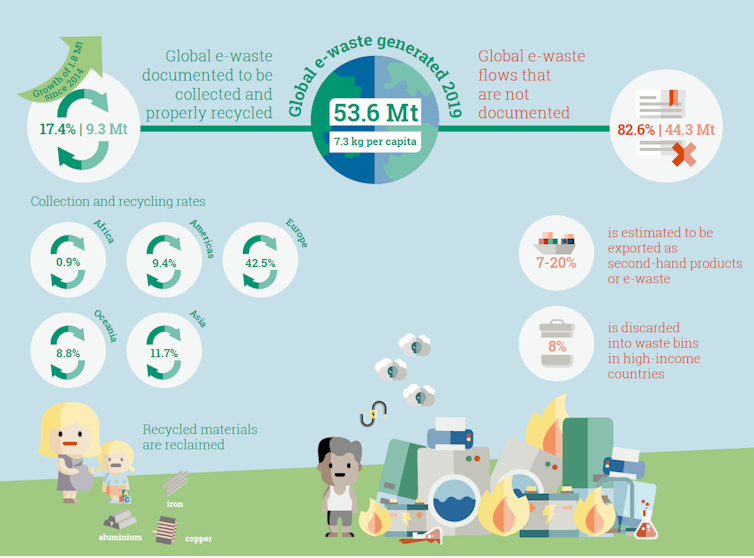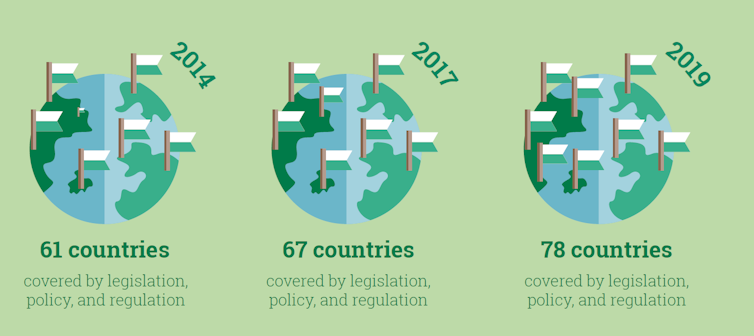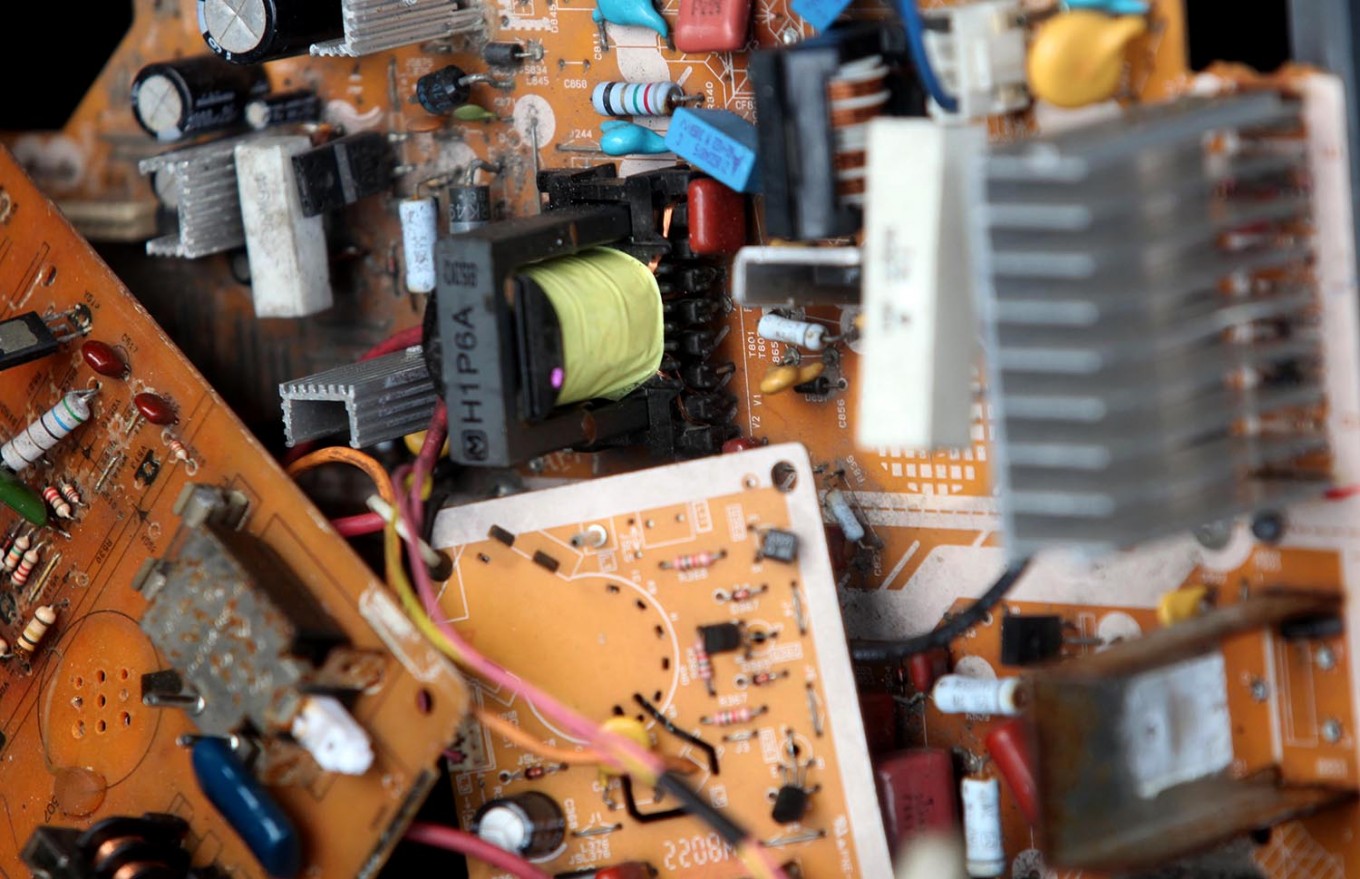Popular Reads
Top Results
Can't find what you're looking for?
View all search resultsPopular Reads
Top Results
Can't find what you're looking for?
View all search resultsGlobal electronic waste up 21 percent in five years, and recycling isn't keeping up
Only 17.4 percent of 2019’s e-waste was formally collected and recycled.
Change text size
Gift Premium Articles
to Anyone
E
ach year, the total amount of electric and electronic equipment the world uses grows by 2.5 million tonnes. Phones, radios, toys, laptops – if it has a power or battery supply it’s likely to join a growing mountain of “e-waste” after use.
In 2019 alone, the world generated 53.6 million tonnes of e-waste. That’s about 7.3 kilograms per person and equivalent in weight to 350 cruise ships. Asia produced the lion’s share – 24.9 million tonnes – followed by the Americas (13.1 million tonnes) and Europe (12 million tonnes), while Africa and Oceania generated 2.9 and 0.7 million tonnes respectively.
By 2030, the global total is likely to swell to 74.7 million tonnes, almost a doubling of the annual amount of new e-waste in just 16 years. This makes it the world’s fastest growing domestic waste stream, fuelled mainly by more people buying electronic products with shorter life cycles and fewer options for repair.
These products can help improve living standards, and it’s good that more and more people can afford them. But growing global demand is outpacing our capacity to recycle or dispose of electronic products safely. Once they’re obsolete and discarded, these products can end up accumulating in the environment, polluting habitats and harming people and wildlife.
E-waste recycling
Only 17.4 percent of 2019’s e-waste was formally collected and recycled. Since 2014, the amount of recycled e-waste has only grown by 1.8 million tonnes each year. The total amount of e-waste generated increased by 9.2 million tonnes over the same period. At the same time, the amount of undocumented e-waste is increasing.
In new research, we found that Europe has the highest collection and recycling rate, covering about 42.5 percent of the total e-waste generated in 2019. Asia ranked second at 11.7 percent, the Americas and Oceania were similar at 9.4 percent and 8.8 percent, and Africa had the lowest rate at 0.9 percent. What happened with the rest (82.6 percent) of the world’s e-waste generated in 2019 isn’t clear.
In high income countries, around 8 percent of e-waste is thought to be discarded in waste bins, while 7-20 percent is exported. In lower income countries, the picture is less clear, as e-waste is mostly managed informally.

Without a reliable system of waste management, toxic substances contained in e-waste, such as mercury, brominated flame retardants, chlorofluorocarbons and hydrochlorofluorocarbons, are more likely to be released into the environment and harm the people who live, work and play in e-waste scrapyards.
Mercury is used in computer monitors and fluorescent lighting, but exposure to it can cause brain damage. We estimated that about 50 tonnes of mercury is contained in these undocumented flows of e-waste that end up in the environment each year.
E-waste doesn’t just pose a health risk though. It also contributes directly to global warming. Dumped temperature-exchange equipment, found in fridges and air conditioners, can slowly release greenhouse gases. About 98 million tonnes are thought to leak from scrapyards each year, equivalent to 0.3 percent of global emissions from the energy sector.
Aside from toxins, e-waste also contains precious metals and useful raw materials, such as gold, silver, copper and platinum. The total value of all this discarded as e-waste in 2019 has been conservatively valued at US$57 billion (£45 billion) – a sum greater than the GDP of most countries.
But since only 17.4 percent of 2019’s e-waste was collected and recycled, just US$10 billion of this was recovered in an environmentally responsible way. Only 4 million tonnes of raw materials was made available for recycling.
Thankfully, the world is slowly waking up to the scale of this problem. As of the end of 2019, 78 countries, covering 71 percent of the world’s population, either had a policy for managing e-waste or were putting regulation in place – an increase of 5 percent from 2017. But in many of these countries, policies still aren’t legally binding and regulation isn’t enforced.

As researchers, we’ll continue to monitor the world’s e-waste to support the creation of a circular economy and sustainable societies. We hope that our efforts to track this growing problem can spur governments to act with an urgency that reflects the scale of the challenge, with laws and enforcement that can drastically increase the proportion of e-waste that’s recycled safely.
---
Vanessa Forti, Programme Associate at UNU-Vie-SCYCLE., United Nations University
This article is republished from The Conversation under a Creative Commons license. Read the original article.











